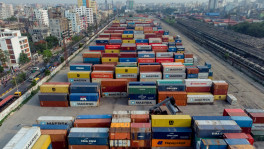Cities no longer change lives of the poor
To create new jobs, dependence on the RMG sector has to be minimised, Dr Hossain Zillur Rahman said

In early 90s, a landless Abdul Mazid and his wife came to Dhaka in search of a better life. He soon obtained a job at an established garment factory in Khilgaon.
But he found it tough to maintain his family as his wages were not rising in the same way as prices of daily essential commodities were going up.
It took two decades for him to experience something of financial comfort in the family when his three daughters and two sons joined him in the apparel factory.

But then frustration came his way when the factory where he worked was shifted to Gazipur.
In order to comply with conditions relating to improving working conditions and ensuring fire safety, the apparel factory had to shift to its own building from a shared one. This was after the deaths of a number of RMG workers in the Tazreen Fashions fire in 2012 and the Rana Plaza collapse in 2013.
Finding no job in other factories, Mazid opened a roadside tea stall with a little capital at Khilgaon Bazar. But his wife Sabina Begum did not join him in his new work.
Mazid has little idea of government statistics, but he does know that his living condition has not improved much despite his stay in the capital for more than two decades.
Like Mazid, many others from the rural areas had been making their way to Dhaka, Chattogram and other cities with hopes of improving their financial circumstances. But many of them failed to reach their goal, with a good number among them seeing their dreams shatter, pushing them into the ranks of the ultra-poor.

A recent World Bank report provides an insight into the issue of poverty reduction in the country.
Between 2010 and 2016, about 80 lakh Bangladeshis came out of poverty, with 90 percent of the poverty reduction taking place in rural areas, according to the report, "Bangladesh Poverty Assessment, Facing old and new frontiers in poverty reduction".
Since 2012, rural areas have been contributing significantly in poverty reduction, but urban areas cannot keep pace with them, resulting in a fall in the overall poverty reduction rate.
According to the report, the poverty rate in rural areas has been declining by 1.42 percent on an average each year for the last six years. In contrast, the poverty reduction rate in urban areas has only been 0.33 percent on average in the same period. As a result, the overall rate has come to 1.17 percent.
From 2005 to 2010, the annual poverty reduction rate in towns was 1.72 percent.
Although the poverty rate in urban areas has been slowly declining, the extreme poverty rate increased to 8 percent from 7.7 percent over the same period.

According to the report, although one in every five poor persons lives in towns now, half the poor population will live in urban areas by 2030, if the current trend of urbanisation, people's migration to urban areas and new employment creation goes on.
In the RMG sector, which has played a big part in poverty reduction, new employment generation has come down to almost zero. And this is what the World Bank has identified as one of the reasons for the rise in the number of poor people in urban areas.
From 2003 to 2015, the apparel sector created three lakh jobs every year, but in 2016 the number came down to 60,000. The sector is now failing to contribute to employment opportunities in towns owing to the relocation of garment factories, use of modern machinery and other reasons.
The latest census figures of the Bangladesh Bureau of Statistics (BBS) show that the rate of unemployment has dropped to 4.2 percent across the country. Unemployment rate in towns is 4.4 percent while in the rural areas it is 4.1 percent.
Meanwhile, some 58 percent of the workforce in urban areas are engaged in the labour market.
A large number of people among the urban population are engaged in the service sector, but that has not led to a decline in poverty at a noticeable rate. In the last six years, the figures for the poor in this sector have risen by 40 percent.

Conditions of the poor in cities
The number of slum dwellers is increasing rapidly in the cities. In the last 17 years, their number has gone up to 23.32 lakh, according to a BBS census on slum and floating people.
The report said 70 percent of them live in city corporation areas. Over 10 lakh slum inhabitants live in Dhaka and over 6 lakh in Chattogram.
According to the Monitoring the Situation of Vital Statistics of Bangladesh (MSVSB), 28 in every 1000 people are shifting to towns every year in Bangladesh. On the other hand, only five persons are going back to villages each year. The pressure of people on big cities like Dhaka and Chattogram is mounting as 49 in 1000 people are shifting from one town to another.
According to the World Bank report, Dhaka's population has been increasing annually by 4 percent, which is twice the figure than in other countries of South Asia.
The Asian Development Bank notes that half of the urban population of the entire country live in Dhaka. Some 12 percent of city people live in Chattogram.
Against this backdrop, experts have recommended undertaking new initiatives alongside conventional strategies in tackling poverty.
According to the last BBS report, the number of poor people came down to 21.8 percent towards the end of 2018. During the same time, the extreme poverty rate dropped to 11.3 percent.

In July last year, the total population in the country was 16.46 crore. Of them, some 3.59 crore people were living below the poverty line. The number of extreme poor was 1.86 crore.
Despite economic development in the country, the marginal sections of people in the cities have not been deriving any benefits from it. Increased investment in education is not throwing up results at a satisfactory level. In the interest of balanced economic development, it is time to think differently about urban areas, said Dr Hossain Zillur Rahman, a former adviser to a caretaker government.
To create new jobs, dependence on the RMG sector has to be minimised. Efficiency in government's spending also needs to be ensured by improving the environment for investment in new sectors, he added.
In the opinion of the urban expert Iqbal Habib, even lower-middle-income people are neglected in city planning, which means that there is no chance for the lower class. In sewage management, safe drinking water, housing and other civic services, from middle-class people to lower class, all have felt a sense of deprivation.

In general, he noted, there is no opportunity for slum dwellers to be sent back to the villages under the existing city-centred government. A few projects envisaging such a movement back to the rural regions is inadequate, he noted.
To reduce the pressure of people in towns, he stressed collecting capital for poor people and giving them freedom to participate in investment.


 Keep updated, follow The Business Standard's Google news channel
Keep updated, follow The Business Standard's Google news channel
















